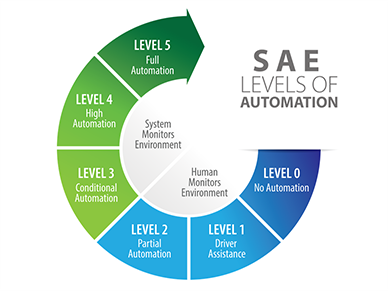Automated Vehicles (AVs) use
sensors and computer systems to drive themselves. Often called
"self-driving" cars, AVs partially or entirely remove the need for a
driver to control the vehicle.
Connected and automated vehicles could increase travel options and make our roads safer. ODOT is monitoring technology developments, evaluating safety benefits, and exploring ways that connected and automated vehicles can increase mobility options for Oregonians.
ODOT is the lead agency
coordinating autonomous vehicle programs and policies in Oregon, as designated by the Legislature in
House Bill 4063 of 2018.
Interested in testing AVs in Oregon?
The Office of Innovative Funding would like to work with any company that is interested in bringing automated vehicles to Oregon. We have a
voluntary testing notification form to initiate the exchange of information between AV manufacturers and ODOT.
Oregon does not currently regulate AV testing, but the voluntary notification process allows ODOT to provide safety information to interested companies on work zones and lane closures on proposed test routes and dates. It also enables us to solicit feedback from AV system developers on how to engage the industry and to track the progress of AV testing in the state.
How does AV technology work?
Automated
vehicle systems require much more testing and validation before they are ready
for commercial deployment. Engineers are working to ensure they drive safely,
closely follow traffic laws, and respond appropriately to changing road
conditions. Automated vehicles do not get distracted and can monitor their
environment in 360-degree, high-precision 3D.
Automated
vehicles can also provide increased mobility to seniors, children, people with
disabilities, and others who are unable or choose not to drive. They could operate
more efficiently than conventional vehicles, reducing congestion and emissions.
Levels of automation

The Society of Automotive Engineers (SAE) has identified six levels of vehicle automation starting with Level 0, or no
automation whatsoever, through Level 5, in which the vehicle has complete
control.
You might already be driving a vehicle that is
above Level 0. Level 1 automation includes automatic transmission, lane-keeping
technologies, and assisted cruise control. Level 2 includes some of these
technologies working in conjunction (such as in Tesla's autopilot mode). Levels 3 through 5 are where the Office of Innovative Funding is focusing its attention.
Oregon's Task Force on Autonomous Vehicles
The Task Force was created by
House Bill 4063 and signed by Gov. Kate Brown on April 10, 2018. ODOT was named the state's lead agency on automated vehicle policy (as recommended by the National Highway Traffic Safety Administration). It also directed ODOT to facilitate a Task Force on Autonomous Vehicles and report to the Legislature with legislative recommendations. Per HB 4063, the Task Force dissolved in January 2021.